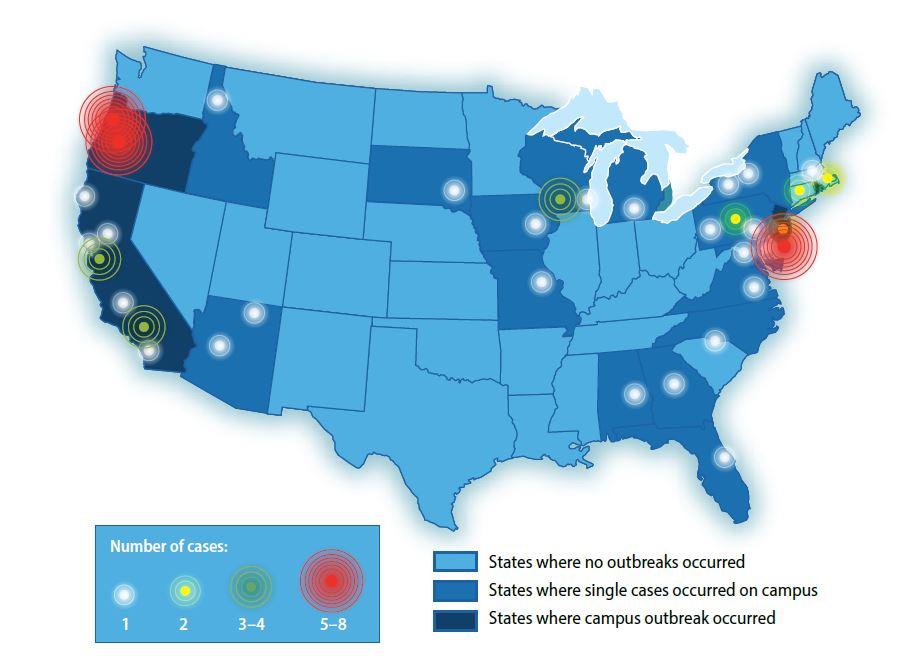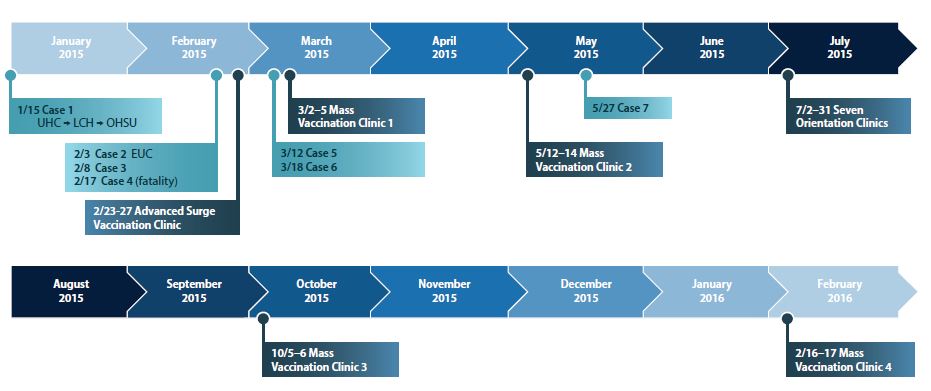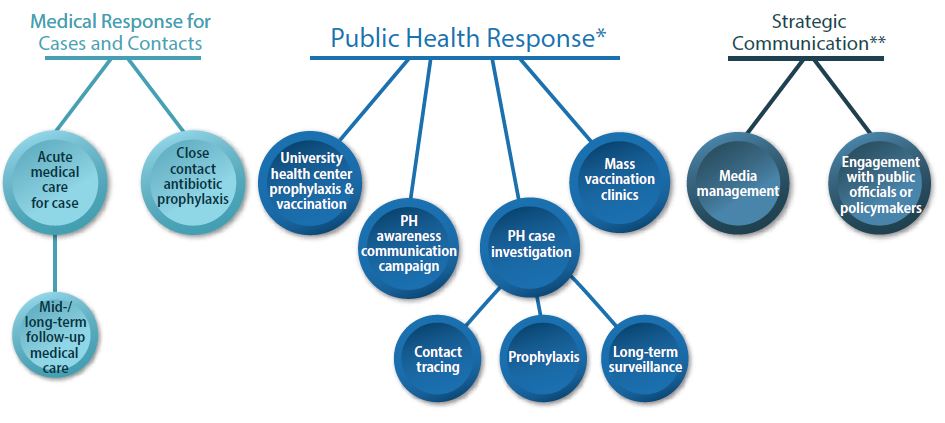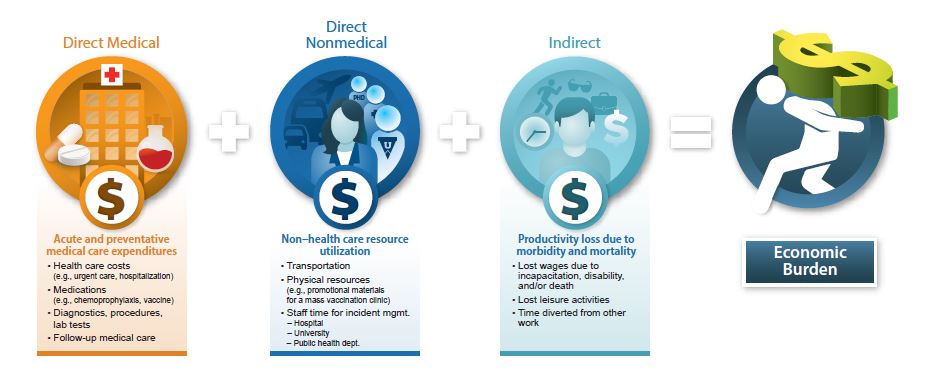Introduction
Invasive meningococcal disease (IMD), a rare contagious infection caused by the Neisseria meningitidis bacteria, typically presents with fever, headache, and neck stiffness. If treatment is delayed, IMD can lead to severe morbidity and mortality. Between 10% and 15% of IMD cases result in death, and among those who survive, nearly 20% live with permanent disabilities such as brain damage, hearing loss, or limb amputation (Centers for Disease Control and Prevention (CDC), 2015).
In the United States, the incidence of meningococcal disease has dropped substantially over the last two decades. In 1997, the incidence was 1.10 per 100,000 population (2,800 cases) (CDC, 1998); in 2014, an estimated 450 cases occurred, a rate of 0.13 per 100,000 population (CDC, 2014). Nearly all instances of IMD are caused by serogroups A, B, C, W, and Y, with serotypes C, W, and Y contributing three-quarters of cases among persons 11 years of age or older (CDC, 2015).
Despite the reduction in incidence of meningococcal disease in the United States in general, there have been numerous cases of meningococcal disease (particularly serogroup B) on US college campuses from 2013 to 2017, with some cases leading to deaths, outbreaks, or both. An outbreak of IMD is generally defined as multiple people infected with the same serogroup in a population (e.g., an organization, school, community) over a short period of time (CDC, 2017b). Although uncommon, IMD outbreaks are unpredictable and can result in substantial socioeconomic consequences. During an IMD outbreak, response time is critical, and rapidly marshalling the personnel and monetary resources to respond is paramount to controlling disease spread (Ahlawat et al., 2000).
A typical IMD outbreak response includes numerous simultaneous activities, including confirmation of cases, acute medical care, contact tracing, dispensing appropriate postexposure antibiotic chemoprophylaxis, enhanced disease surveillance, strategic communications with the media and the public, and planning and implementation of public health measures (e.g., policy implementation, mass vaccination clinics) (Abbas et al., 2016). However, emergency response budgets are limited and thus often unable to quickly and effectively manage an outbreak, which can require up to thousands of staff hours and millions of dollars in resources. If an affected community lacks existing policies and resources necessary to quickly and efficiently respond to an IMD outbreak, the resulting costs associated with response activities can be overwhelming.
Since 2008, 11 outbreaks of serogroup B IMD have occurred in a university setting in the United States. Figure 1 maps single cases and outbreaks occurring on university and college campuses in the United States from 2013 to 2017. Characteristics of these outbreaks have varied. The total number of cases has ranged from 2 to 13; and outbreaks have occurred at schools with undergraduate cohorts ranging from 4,000 to 35,000 students, and lasted several days to multiple years (CDC, 2017a). To date, potential risk factors for university-based outbreaks have not been identified (CDC, 2018), suggesting preventive measures and careful emergency preparedness planning may be the most feasible method for mitigating future outbreaks.
Figure 1.
42965Invasive meningococcal disease outbreaks on US university and college campuses (2013–2017)
Note: Figure adapted from the National Meningitis Association (2017).

To maximize limited resources and enable a rapid response, proper planning should be undertaken before an emergency arises. As such, health care stakeholders (e.g., public health officials, providers) should give attention to gaining a fuller understanding of the complex interactions of parties engaged in the response and the scope of the economic burden associated with the response. To date, there is no comprehensive estimate of the economic burden of an outbreak (Anonychuk et al., 2013). Traditional approaches do not account for the complex nature of an outbreak and therefore may underestimate its true burden. Accordingly, the aims of this study were twofold, ultimately allowing for a more robust estimation of the burden of an outbreak. First, we endeavored to develop a conceptual framework of the broad, multifaceted response to a meningococcal outbreak. We then sought to estimate the total economic cost (i.e., inclusive of direct medical, direct nonmedical, and indirect costs) associated with these activities using data from two recent university outbreaks in Oregon as case studies. Both the framework and understanding the economic cost of an outbreak response can help inform budgeting for future outbreak preparedness and provide a baseline for comparison of strategies in IMD control.
Methods
Our objective in using the conceptual economic framework was twofold. First, we established the complex and dynamic situation surrounding an outbreak response. Second, we allowed for partitioning costs and resources for each component in a manner that allows for a more-transparent planning exercise. To develop the conceptual economic framework of an IMD outbreak response and document the economic burden of an outbreak in the context of the framework, we examined responses to two meningococcal outbreaks that occurred on Oregon university campuses in 2015 and 2016. The first outbreak occurred at the University of Oregon (UO) in Eugene, Oregon, and the second occurred less than 50 miles north at Oregon State University (OSU) in Corvallis, Oregon. Both outbreaks were relatively large, with six confirmed cases at OSU and seven at UO. We identified activities involved in these responses through publicly available sources. Because more details were publicly available for the UO outbreak, most activities included in the framework were based on characteristics of the UO outbreak (e.g., number of cases, number of vaccinations). Where information about the UO outbreak was unavailable, activities associated with the OSU outbreak were used (e.g., staff time related to incident management), where available. Figure 2 describes the timeline of events in the UO outbreak.
Figure 2.
42964University of Oregon outbreak timeline
Note: EUC = Eugene Urgent Care; LCH = Lebanon Community Hospital; OHSU = Oregon Health and Science University; UHC = University Health Center.

Using the conceptual framework as a guide, we estimated the cost of an outbreak by collecting cost data from public sources and unstructured interviews with key personnel (i.e., physicians, health system staff, and public health administrators) involved with either or both of the university-based outbreaks. We applied those costs to each resource included in the categories of the conceptual framework, when available. All interviewees agreed to provide their insight under the condition of remaining anonymous.
The components of the outbreak costs and associated response were organized as shown in Figure 3, with three distinct cost “centers” making up the total cost burden.
Results
Conceptual Economic Framework
A conceptual framework was developed that partitions the outbreak response into distinct sectors (Figure 4). Accordingly, portions of these component sectors can in turn be mapped to the cost centers presented in Figure 3, although the mapping is not exact (i.e., portions of a sector can fall into more than one cost center). For example, the mass vaccination clinic portion of the public health response has direct medical, direct nonmedical, and indirect costs associated with it (further illustrated in Table 1). Thus, we were unable to allocate total mass vaccination clinic costs to specific cost centers.
Figure 4.
42962Conceptual framework depicting the response to a meningococcal outbreak on a university campus
PH = public health.
* Includes the public health responses from state, county, university, and local providers.**
** Incident management directs the coordination of internal public health resources to support the outbreak and manages external communication with the community. Incident management structure may be coordinated across organizations or developed as separate systems within each organization.

Medical Response for Cases and Contacts
Early diagnosis and rapid treatment are critical in reducing the risk of morbidity and mortality from IMD. The two most common manifestations of meningococcal disease are meningitis and septicemia. Symptoms of meningococcal meningitis typically include fever, headache, and neck stiffness, whereas symptoms of meningococcal septicemia often include fever, fatigue, and hemorrhagic rash and may progress to septic shock. Diagnostic procedures often include blood cultures, coagulation studies, lumbar puncture, and computed tomographic brain imaging. Treatment includes parenteral antimicrobial therapy for 5 to 7 days, typically, and individualized supportive care ranging from intravenous fluid resuscitation to mechanical ventilation. Individuals who develop severe coagulopathy (known as purpura fulminans) in their extremities sometimes require amputation of digits or full limbs. Upon hospitalization, individuals with IMD require droplet isolation precautions until they have received an effective antibiotic for at least 24 hours (Nadel, 2016; personal interview, April 10, 2018).
Sequelae can be debilitating and irreversible and may include chronic pain; scarring; neurologic, visual, and hearing impairment; impaired motor abilities; seizures; septic arthritis; chronic meningococcemia; amputation; and psychological disorders. Follow-up care is typical and varies by complication (e.g., hearing tests, physical and occupational therapy, psychological and psychiatric therapy, wound care).
When close contacts of each case are identified, antimicrobial chemoprophylaxis (i.e., oral rifampin, oral ciprofloxacin, or intramuscular ceftriaxone) is administered to prevent secondary cases (CDC, 2017a). Each close contact is evaluated and counseled by a health care worker. Health care workers will (1) review medication allergies and contraindications with the patient to choose an appropriate antimicrobial, (2) review risks and benefits of chemoprophylaxis with the contact, and (3) ensure the contact is able to obtain and complete the full course of chemoprophylaxis in a timely fashion.
Public Health Response
The public health response includes activities aimed at preventing the spread of the disease. The overall response involves four distinct strategies coordinated by one or multiple incident command teams, typically consisting of members from the state and county public health departments/laboratories, university, and community partners (e.g., local providers/health plans) (personal interview, April 10, 2018). These strategies include the following:
Public health case investigation: When the first case is suspected, specimens are typically confirmed by bacterial culture and tested for serotype at a public health laboratory (Personal interviews, April 10 and 24, 2018). When multiple cases are confirmed, local and state public health staff enhance surveillance; two or three cases may lead to activation of an incident command system (Personal interview, April 24, 2018). Epidemiologists from the local and state public health departments, in collaboration with the university and medical providers, investigate links between cases and trace people who may have come in close contact with each case to characterize the population at greatest risk of infection (personal interviews, April 10 and 24, 2018).
Mass vaccination clinics: Vaccination is the primary control method for preventing the spread of IMD (CDC, 2017a). In a university setting, mass vaccination clinics can be implemented to immunize a large number of students quickly. To stage a mass vaccination clinic, organizers must identify and secure a location large enough to handle a high volume of students, obtain and store a large quantity of the vaccine, develop and implement billing systems, secure medical providers and volunteer staff, and publicize the event to the at-risk population (Grabenstein & Nevin, 2006; personal interview, May 1, 2018).
University health center chemoprophylaxis and vaccination: During the outbreak, university health centers may experience an increase in students seeking care for potential symptoms, chemoprophylaxis, and vaccination. The response may require an increase in administrative support to field a higher volume of phone calls as well as additional nursing staff to provide care and vaccination (personal interview, May 21, 2018).
Public health awareness communication campaign: Effective communication is critical to controlling an outbreak as quickly as possible. Communication campaigns that provide timely, transparent, and accurate information can build and maintain trust with the at-risk population and other stakeholders (World Health Organization, 2005). Effective public health communication can assist in garnering needed public participation in implementing containment and prevention strategies.
Ongoing public health surveillance occurs over a 1-year period following the last case in the outbreak. Monitoring activities include active population- and laboratory-based surveillance and updates to local and national health authorities (e.g., CDC) (personal interview, April 24, 2018).
Strategic Communication
In addition to coordinating the proactive public health response to an outbreak at the onset, the incident command team is typically tasked with developing strategic communication plans to provide updates to both involved parties (e.g., health care providers, university staff) and the public at large and disseminate critical information during the course of the outbreak (Reynolds & Quinn, 2008; personal interviews, April 10 and 24, 2018), as well as securing and allocating required funding to cover the response via national, state, and local government agencies and other funding mechanisms (Posid et al., 2013; personal interviews, April 24, 2018, and May 21, 2018). Communication activities typically include:
Media management: After an outbreak starts, the incident command team develops and distributes relevant news releases, coordinates news conferences, and uses other mechanisms (e.g., e-mail campaign, Facebook, Twitter) to notify the public of an outbreak (personal interviews, April 24, 2018, and May 21, 2018).
Engagement with public officials or policy makers: Obtaining funding might entail meeting with legislatures and other emergency response groups to acquire financial support, enact legal support, and retain the physical resources necessary to maintain the public health response (personal interviews, April 24, 2018, and May 21, 2018).
Estimated Cost Burden
We obtained information on units of resource use and associated costs through the unstructured interviews. We collected additional resource use and unit cost data from published literature when details specific to UO and OSU were not available. Other resources that could not be reasonably quantified (e.g., time diverted from other activities) were not estimated.
Table 1 presents estimated resource use and associated costs for managing an IMD outbreak, using data from the UO and OSU events and public sources. The UO and OSU outbreaks included seven and six confirmed cases, respectively. Because the resource use and cost information were drawn from both outbreaks, we have assumed seven confirmed cases for this analysis. Under these assumptions, we estimate the total cost of responding to an outbreak to be $12,301,975. The largest component of the total, $8,035,178, was attributable to direct medical costs. Within the direct medical cost category, most of the cost was from the mass vaccination clinic. The underlying data reflected an assumption that 22,000 vaccinations were provided in and around the UO community, which is likely more than were actually provided (as discussed in the Limitations section of this paper), resulting in total cost of vaccines of $7.6 million, or approximately $330 per vaccination. It should further be noted that this figure contains only an estimate of the retail price for the vaccine itself and does not include administration costs. Provision of acute medical care and case investigation/ascertainment activities were the next-largest components of direct medical costs, although they cost less than the mass vaccination clinic efforts. Total direct nonmedical and indirect costs were $1,820,681 and $2,446,116, respectively. Most direct nonmedical costs were attributable to a wrongful death settlement ($1,500,000) and nearly all indirect costs are from the calculation of productivity loss due to early death.
With seven confirmed cases, the total cost per case was approximately $1.8 million. It should be noted that, as shown in Table 1 other relevant components were either unavailable or not estimable. As such, the true cost burden is likely greater than reflected here.
Table 1.
42995Resource utilization and estimated costs
PCR = polymerase chain reaction; PR = public relations.
a Unit cost obtained from Agency for Healthcare Research and Quality (2008).
b Unit cost obtained from HCUPnet (2015).
c Assuming wage loss of $10 per hour for a part-time student worker at Oregon State University [OSU] (Glassdoor, 2018) and a mean length of stay of 9.5 days (Candrilli & Kurosky, 2018).
d Unit cost obtained from Davis, Misurski, Miller, Bell, et al. (2011).
e Unit cost obtained from Carnevale et al. (2013).
f Unit cost obtained from Oregon Health Authority (n.d.). Assuming 15 close contacts per case (Bapat et al., 2009).
g Assuming wage loss of $10 per hour for a part-time student worker at OSU (Glassdoor, 2018) and 2 hours spent in travel, receiving medical care, and filling a prescription.
h Assuming wage loss of $10 per hour for a part-time study worker at OSU (Glassdoor, 2018) and 2 hours spent in travel and receiving medical care. Number of medical encounters obtained from Davis, Misurski, Miller, & Karve (2011).
i Number of units obtained from Dillon, Haubenreiser, Stocker, and Nuttbrock (n.d.). Unit cost obtained from Oregon Health Authority (n.d.).
j Number of units obtained from personal interview (May 21, 2018). Assuming part-time student worker wage of $10 per hour.
k Assuming wage loss of $10 per hour for a part-time student worker at OSU (Glassdoor, 2018) and 2 hours spent in travel, receiving medical care, and filling a prescription/receiving vaccination.
l Unit cost obtained from Ingenix, Inc. (2017).
m Cost obtained from Bapat et al. (2009).
n Cost obtained from personal interview (April 24, 2018).
o Cost estimated from personal interview (May 1, 2018).
p Cost estimated from personal interview (May 21, 2018).
q Resource use estimated from Krause et al. (2002).
r Cost estimated from Oregon State Legislature (2016a).
s Cost obtained from Dillon et al. (n.d.).
t Number of units estimated from personal interview (May 21, 2018). Unit cost obtained from Independent Sector (2018).
u Cost estimated from personal interview (May 21, 2018). Assuming wage loss of $10 per hour for a part-time study worker at OSU (Glassdoor, 2018) and 1 hour spent in travel and attending the clinic.
v Cost estimated from personal interviews (April 24, 2018, and May 21, 2018).
w Cost obtained from Associated Press (2017).
Discussion
As illustrated in this study, the response to a meningococcal outbreak is multifaceted and wide-reaching. The full scope of the response encompasses health care providers; local clinics and pharmacies; university staff and students; media; national, state, and local government officials; legal resources; volunteers; employers; insurers; patients, close contacts, and family members; community members; and law enforcement.
Although limited contemporary data from the United States quantify the economic burden of an IMD outbreak at a macro level, it is useful to interpret the results from this study in the context of other available published literature. Anonychuk and colleagues (2013) presented results from a systematic literature review of the cost and public health burden of IMD outbreaks around the world. Results from the review were stratified by low- versus high-income countries and then within those groups by small versus large containment strategies (e.g., targeting all members of the school where the outbreak occurred vs. targeting everyone in the community). Among high-income countries, the average cost per small containment strategy was $229,641 and the average cost per IMD case was $41,857, whereas the average cost per large containment strategy was $579,851 and the average cost per IMD case was $55,755. However, the true cost burden is likely much greater than reflected in the review by Anonychuk and colleagues. Our study reflects a wide range of resources not accounted for in the studies reviewed (e.g., indirect burden, costs associated with fatality), as well as differences in the types of vaccines administered, as meningococcal serogroup B vaccines are relatively new. With seven confirmed cases used in our cost estimation, the total cost per case was approximately $1.8 million, suggesting that previous estimates are most likely quite conservative in scope.
During the UO outbreak, nearly $900,000 was requested by the University of Oregon, state and county health departments, and a community college to assist in direct costs for response activities, yet only 78% of the funds were received (Oregon State Legislature, 2016a, 2016b). In addition to the shortage of close to $200,000, countless unanticipated downstream and incidental costs were not accounted for in the initial request. Our analysis estimated a direct economic cost of upwards of $8 million associated with an IMD outbreak, indicating that just over 11% of the estimated direct economic costs were requested and even less were received. The uncovered cost of the outbreak would then rest on the schools, students, health plans and providers, and the surrounding community.
Measles, another communicable disease, has also been a considerable burden on community resources in the United States. Notably, a measles outbreak in 2013 in New York City with 58 cases and more than 3,000 close contacts involved 87 health department staff who logged more than 10,000 hours responding to the outbreak (Rosen et al., 2018). The cost in salary to the city’s health department was nearly $400,000. Although this underestimates the total burden of an outbreak, Schwartz (2018) highlights that the sheer cost of staff time alone “underscore[s] the resource-intensive nature of public health responses to vaccine-preventable disease outbreaks.”
Because of the complex dynamics of the response, estimating the total cost of the effort is complicated, and previous appraisals are likely substantially underestimated. The data developed as part of this project support this, as our findings are substantially larger than previously published estimates. Changing the approach for measuring IMD burden is necessary to improve our understanding of the societal consequences of this devastating illness, and historically, quantifying the operational aspects of outbreak management is often neglected (Perrett et al., 2000).
As evidenced by the two outbreaks assessed in this study, mobilizing and implementing a response is complex, and anticipating the resources and activities that may be needed is difficult. Well-informed planning can support efficient task delegation, identification of gaps in response, effective allocation of resources, and proactive communication to the public (Stewart et al., 2013). However, cuts to federal funding to state and local health authorities continue to decrease the public health workforce and capacity to respond to infectious disease outbreaks. Comprehensively documenting the burden of a disease outbreak is crucial for informing response planning, particularly in times of shrinking public health funding. In recent years, federal support for public health preparedness has fallen, forcing clinics to make substantial cuts in staff and preparedness activities. Such “cuts translate directly to a decreased ability to mount a timely, effective response to routine and extraordinary threats, including infectious diseases” (Watson et al., 2017). Thus, in resource-constrained environments, more-precise, more-robust estimates may inform decision-making around designing public policy and allocating resources for future outbreaks. Precisely mapping the dynamics of the response could help lead to a better-coordinated effort and more-efficient process, which may in turn help reduce costs in the wake of reduced public funding.
Limitations
Limitations to this study should be acknowledged. Available data are not sufficient to calculate true costs. As such, assumptions and approximations from published literature were required, and costs are likely substantially underestimated. Data on the cost of vaccines were drawn from a report from the Oregon State Legislature regarding the UO outbreak vaccination program (Oregon State Legislature, 2016a). As described in the report, the Centers for Disease Control and Prevention, the Oregon Health Authority, and the Lane County Public Health Department recommended that UO vaccinate all of its approximately 22,000 students. However, “the actual number of UO students vaccinated is not included in the submitted report primarily due to the non-disclosure price agreement for the vaccines and the inability to reconcile the multi-dosage requirements of the vaccine with the level of student detail available in the ALERT Immunization Information System” (Oregon State Legislature, 2016a).
The submitted report further indicated that had the university purchased the required number of doses at the current market rate, the total cost would have been approximately $7.6 million to vaccinate all 22,000 students, which is the estimate we used in this paper. Variations in vaccination parameters, however, can significantly change the total cost burden. For example, if only a fraction of the total student population was vaccinated (e.g., all students living in campus housing but only a small portion of students residing off-campus), or if the vaccine cost itself was less than assumed for the study presented in this paper, the difference in the cost burden (both direct and total) may be significant. Accordingly, and because such a substantial portion of the total cost burden is attributable to vaccine costs, more detailed information on both the true cost of the vaccines and the total number provided will allow for a more-precise estimate of the total cost burden.
In addition, these vaccine cost data did not include detail on the vaccines actually administered, so it was not possible to assess the specific impact that any particular vaccine or negotiated purchasing parameters (e.g., the state purchases vaccines from the manufacturer at a discounted rate) might have on the total cost burden. Furthermore, indirect/intangible costs attributed to lost wages, societal contribution, leisure activity, and other “downstream” behaviors (e.g., an incoming freshman declining acceptance to a school because of outbreak-induced fear) are not easily “valued” and were not applied to this analysis.
Case studies are contextual, and generalizability of these findings may be limited. The results presented here are framed in a societal perspective. However, details on who ultimately was responsible for paying for the resources used and consumed are not readily available. As such, presenting these findings in the context of other perspectives was not possible within the scope of this study. Future studies that attempt to further partition the cost burden into narrower segments or perspectives will provide valuable information to the IMD body of research.
Each outbreak is unique, and the economic burden generated by another outbreak on a different university campus would likely vary from the burden presented in this analysis. However, these findings can be valuable for general planning and identification of activities and costs that local stakeholders may not have already considered.
Key Findings
Findings/lessons learned may be used for ongoing planning and preparedness activities within a university, local/state government, and community organizations
-
Vaccination policy implications
-
Streamlining response efforts
Assist in planning for future outbreaks
Develop a tool box to assist in media communication, incidence command structuring, and mass vaccination clinics
Develop simple tools for documenting activities, time, and effort spent on responding to an outbreak for post-outbreak evaluation of the true cost burden to stakeholders (e.g., students, government, health plans and local providers, community organizations)
Advocate for policies to support outbreak response (e.g., insurance/billing barriers, routine vaccination recommendations, emergency funding)
-
Future research needs
Development of a cost calculator to allow organizations to estimate/plan for expenses prior to or during an outbreak.
As the timing, number of cases, and location of an outbreak frames the required response activities, explore activities and cost burden of a variety of different college outbreaks is needed to develop a more comprehensive understanding of the economic burden of meningococcal disease outbreaks in academic settings.
Future Considerations
Findings from this study may be used for ongoing planning and preparedness activities within a university, local/state government, and community organizations. In a recently published study of a meningitis outbreak, Burmaz and colleagues (2019) championed the need to develop prescriptive guidelines for defining and managing meningococcal outbreaks. Activities that are important to undertake during development of such guidelines are likely to include an evaluation of vaccination policy, development of a coordinated media response plan (e.g., as described by Singleton et al., 2000), and developing policy tools.
In addition to increasing understanding of the complex dynamics and economic burden of an outbreak and its coordinated response, findings from this study may assist with planning aimed at streamlining response efforts. Such planning may include developing a tool box to assist in key points of strategic communications during an outbreak; an incident command system and the incident management team’s role; mass vaccination clinics; and simple tools for documenting activities, time, and effort spent on responding to an outbreak for post-outbreak evaluation of the true cost burden to stakeholders (e.g., students, government, health plans and local providers, community organizations). Developing guidance on how to market and communicate mass vaccination clinics to students and planning technology and equipment needs may help reduce operational burden during an outbreak.
Findings from this study indicate that advocating for policies to support outbreak response (e.g., insurance/billing barriers, routine vaccination recommendations, emergency funding) would help prepare universities for challenges presented when faced with an outbreak. In particular, interviewees highlighted that substantial time was spent navigating insurance and billing barriers for students and triaging students to different community providers to ensure vaccination fees were covered by their insurance. Legislation to support insurance coverage of vaccines during an outbreak, contracts to allow student health services to provide medical or pharmacy services in this environment, or both could support vaccination strategies that are more efficient and economical.
Although this study adds important information to the published literature, there are certainly extensions to this work to consider. Future research should include development of a cost calculator to allow organizations to more-comprehensively estimate and plan for expenses before or during an outbreak, something that is not widely documented (Anonychuk et al., 2013). Because the timing, number of cases, and location of an outbreak all affect the required response activities, more university outbreaks should be examined. Research must explore the existing variety in activities and cost burden to develop a more-comprehensive understanding of the economic burden of IMD outbreaks in academic settings.
Acknowledgments
Sean D. Candrilli and Samantha Kurosky are employees of RTI Health Solutions. This study was conducted by RTI Health Solutions under the direction of GlaxoSmithKline [GSK] and was funded by GSK. Editorial support was provided by John Forbes of RTI Health Solutions. Graphics services were provided by Ryan Miller of RTI Health Solutions. The authors would like to acknowledge the contributions of Rocco Zullo and Cosmina Hogea of GSK, and Jennifer DeBerardinis, formerly of GSK, in the development and critical review of the manuscript.


